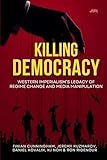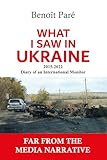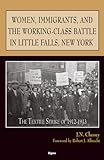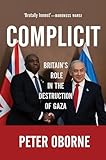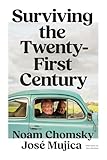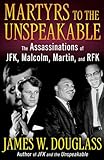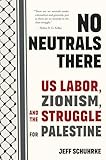A team of public health researchers have called for the expunging of the term “ethnic cleansing” from official use, declaring that it “bleaches the atrocities of genocide and its continuing use undermines the prevention of genocide.”1Rony Blum, Gregory H. Stanton, Shira Sagi and Elihu D. Richter, “‘Ethnic cleansing’ bleaches the atrocities of genocide,” The European Journal of Public Health Advance Access, 18 May 2007: 5 of 6.
In their paper, published in The European Journal of Public Health (EJPH), the researchers, Rony Blum, Shira Sagi and Elihu D. Richter in Jerusalem and Gregory H. Stanton in Fredericksburg, VA, write that the term “ethnic cleansing” emerged politically with Slobodan Miloševic to what he deemed the Kosovar Albanians’ violence against Serbs. Blum et al. lament the creeping prominence “ethnic cleansing” has since gained, especially in diplomatic and legal language, noting that it has even entered the lexicon of the United Nations.
The problem is that, unlike “genocide,” “ethnic cleansing” has no legally recognized status and no legal obligations.
The researchers draw a historical link to such phrases as Judenrein (used by Nazis to refer to an area without Jews; rein means “pure, clean” in German). “The genocides of the past century have shown the propagation of an in-group exterminatory exclusivity based upon myths of hygiene or purity, and dehumanization of the other group, are warning signs of imminent genocide.”Blum et al., 1 of 6. To which I would append “or a genocide in perpetration.”
Some experts point to a vagueness over what “ethnic cleansing” is. Andrew Bell-Fialkoff, author of Ethnic Cleansing, wrote that “ethnic cleansing”
defies easy definition. At one end it is virtually indistinguishable from forced emigration and population exchange while at the other it merges with deportation and genocide. At the most general level, however, ethnic cleansing can be understood as the expulsion of an ‘undesirable’ population from a given territory due to religious or ethnic discrimination, political, strategic or ideological considerations, or a combination of these.2Andrew Bell-Fialkoff, “A Brief History of Ethnic Cleansing,” Foreign Affairs, Summer 1993.
The definitional murkiness plays into the hands of genocidaires. Blum et al. argue, “The role of ‘reverse jargon’ in reversing ordinary social ethics has been crucial to the genocidal agenda of the perpetrators and to sustaining in-group self-esteem. The term ‘ethnic cleansing’ ‘normalizes’ the delusion that massacres are measures to promote ‘hygiene.’”3Blum et al., 2 of 6.
The researchers identify avoidance of the term “genocide” as a pretext for inaction.4Blum et al., 4 of 6. They speculate that earlier labeling as “genocide” may have saved tens of thousands of lives in Bosnia, Kosovo, Rwanda, and Darfur.
Herein lies a criticism of the study by Blum et al. While the etymology of the term “ethnic cleansing” and its misuse demand attention and action, the examples provided in the paper by Blum et al. are suggestive of an agenda. The regions where they determined genocide to have occurred (Bosnia, Kosovo, Rwanda, and Darfur) are those that concur with the expressed view of the United States government. Aside from Rwanda, the occurrence of genocide is disputed. The International Court of Justice determined that Serbia committed no genocide in Bosnia.5“ICJ: Serbia not guilty of Bosnia genocide but broke law by not preventing Srebrenica,” JURIST, 26 February 2007. Veteran journalist John Pilger referred to Kosovo as “the site of a genocide that never was”;6John Pilger, “John Pilger reminds us of Kosovo,” New Statesman, 13 December 2004. this was backed by a UN court.7“Kosovo assault ‘was not genocide,’” BBC News, 7 September 2001. Darfur is the scene of African Muslim fighting African Muslim. Neither the UN nor EU finds Darfur to be a genocide.8Rupert Cornwell, “Darfur Killings Not Genocide, Says UN Group,” Independent (UK), 31 January 2005. Rory Carroll, “Sudan massacres are not genocide, says EU,” Guardian, 10 August 2004. Neither do the CIA nor MI6 who deal openly with Sudanese government officials.9Jonathan Steele, “Darfur wasn’t genocide and Sudan is not a terrorist state,” Guardian, 7 October 2005. Steele held that there is “not genocide or classic ethnic cleansing” in Darfur, rather it “was, and is, the outgrowth of a struggle between farmers and nomads.”
Missing from Blum et al.’s study are, for instance, the genocides in the Democratic Republic of Congo (DRC), Iraq, and Palestine.
Genocide in the DRC
Genocide has been wreaked in the Congo since before the days of the genocidal Belgian monarch Leopold. In Leopold’s day it was elephant tusks and rubber that spurred European greed.10Adam Hochschild, King Leopold’s Ghost: A Story of Greed, Terror and Heroism in Colonial Africa (Boston: Houghton Mifflin Co., 1999). The plunder of the DRC’s resources still attracts western corporations.11Kim Petersen, “Canadian Predation in Africa,” Dissident Voice 5 June 2003. The people of the DRC still suffer.
Dr. Les Roberts’ epidemiological studies into Iraqi civilian mortalities stirred up some minor controversy in the corporate media before being directed to the Memory Hole. Previously, he had less controversially led survey teams in the DRC which concluded:
- 1.7 million excess deaths or more have occurred over the past 22 months as a result of the fighting in the eastern DRC. This equates to 77,000 deaths per month and the IRC believes this is a conservative estimate.
- Young children are missing from the demographic profile. Some 34 percent of the excess deaths are children under five and, depending on the location, 30 to 40 percent are children under two years of age. In addition to the violent deaths of children in battles zones, it is presumed that excessive infant mortality rates and high maternal death rates have contributed to this troubling discovery.
- Violent deaths and “non-violent” deaths are inseparable.
…
- Violence against civilians is indiscriminate. Women and children constituted 47 percent of the violent deaths reported.12“Mortality Study, Eastern D.R. Congo (April-May 2000),” International Rescue Committee, 2000.
Several writers report a figure of 4 million Congolese killed. One writer pointed the finger at western corporations’s lust for the DRC’s “black gold” of coltan, used to make tantalum capacitors for cell phones and other high-tech electronics, as driving the genocide.13Sprocket, “High-Tech Genocide,” Lughnasadh (July-August 2005). Available at Earth First! Journal. Press Release, “Security Council Condemns Illegal Exploitation or the Democratic Republic of Congo’s Natural Resources,” UN Security Council, 5 March 2001.
Foreign traders sell the coltan to just three companies: Cabot Inc. of the US, Germany’s HC Starck and China’s Ningxia. Only these firms are capable of refining coltan into the desired tantalum powder. The tantalum powder is sold to Nokia, Motorola, Compaq, Sony and other manufacturers.Sprocket.
News of the millions killed in the DRC, however, has been largely propagandized or marginalized in the corporate media.
Genocide in Iraq
This use of racist epithets characterizes the language of US occupation soldiers to describe Iraqis. US soldier Joshua Key wrote:
Iraqis, I was taught to believe, were not civilians; they were not even people. We had our own terms for them. Our commanders called them ragheads, so we did the same. We called them habibs. We called them sand niggers. We called them hajjis; it wasn’t until I was sent to war that a man in Iraq explained to me that hajji was a complimentary term for a Muslim who had made the pilgrimage to Mecca. In training, all I knew was that a hajji was someone to be despised…14Nilanjana S. Roy, “Jarheads, ragheads and deserters,” BS Online, 22 May 2007.
Former staff sergeant Jimmy Massey, a 12-year veteran of the Marines described the US-initiated violence in Iraq: “As far as I’m concerned, the real war did not begin until they saw us murdering innocent civilians. I mean, they were witnessing their loved ones being murdered by US Marines. It’s kind of hard to tell someone that they are being liberated when they just saw their child shot or lost their husband or grandmother.”
Massey unequivocally identified what was happening in Iraq. “We are committing genocide in Iraq,” he bluntly declared, “and that is the intention.”15Jeff Riedel, “We’re committing genocide in Iraq,” World Socialist Web Site, 11 November 2004.
That the US-uk invasion-occupation is a genocide in perpetration is attested to by excess mortality data published in the esteemed medical journal the Lancet. The researchers carried out a national cross-sectional cluster sample survey of mortality in Iraq, randomly selecting 50 clusters from 16 governorates between May and July in 2006. They concluded a probability that 655,000 excess mortalities had occurred since the invasion in March 2003. The researchers also stated that the mortalities were on a year-by-year increase.16Gilbert Burnham, Riyadh Lafta, Shannon Doocy, and Les Roberts, “Mortality after the 2003 invasion of Iraq: a cross-sectional cluster sample survey,” Lancet, 368: 21 October 2006: 1421-1428.
One academic extrapolated and updated the Lancet data, arriving at a figure of a million excess civilian mortalities among Iraqis.17Gideon Polya, “US Iraqi Holocaust And One Million Excess Deaths,” Countercurrents, 7 February 2007. This does not include the genocidal UN-US sanctions prior to 2003 that killed another million or more Iraqis.
Genocide in Palestine
Zionists’s dehumanization of Palestinians is well documented. Various Israeli prime ministers have called Palestinians, among other slights, crocodiles, cockroaches, beasts on two legs, and non-existent. Scholar Noam Chomsky said, “Contempt for the Arab population is deeply rooted in Zionist thought.”18Noam Chomsky, Fateful Triangle: The United States, Israel & The Palestinians (South End Press, 1999).
In March, I reviewed ex-patriate Israeli historian Ilan Pappe’s recent book19Ilan Pappe, The Ethnic Cleansing of Palestine (Oneworld Publications, 2006). that forthrightly affirmed that Zionists had carried out an ethnic cleansing of Palestine. Gary Zatzman and I took exception with Pappe’s fudging on the question of genocide.
Pappe writes, “Massacres accompany the operations [of ethnic cleansing], but where they occur they are not part of a genocidal plan: they are a key tactic to accelerate the flight of the population earmarked for expulsion. (p. 2) [italics added]
“Ethnic cleansing is not genocide, but it does carry with it atrocious acts of mass killing and butchery.” (p. 197) [emphasis added] Pappe is generous with the definition of “ethnic cleansing” (e.g., “part of the essence of ethnic cleansing is the eradication, by all means available, of a region’s history”) but parsimonious with the definition of “genocide.”
Pappe considers 1948 is a “clear cut case, according to informed and scholarly definitions, of ethnic cleansing.”
Simply put, “genocide” is the killing of a group, and “ethnic cleansing” is the removal of a group. But “genocide” is not so simple. Article 2 (a,b,c, & d) of the Convention on the Prevention and Punishment of the Crime of Genocide seems to apply well to the case of 1948 and also today.20Kim Petersen, “Nakba: The Israeli Holocaust Denial,” Dissident Voice, 18 March 2007.
Linguistic Cleansing
The EJPH paper calls for linguistic accuracy so that agents of flagrant criminal actions will bear full culpability and responsibility. Blum et al. compellingly make the case for ditching the term “ethnic cleansing” and calling genocide what it is. Given the horror and massive moral repulsion of genocide, linguistic cleansing is required. I had previously used “ethnic cleansing” in the denotation of “forced mass expulsions,” unaware of its sinister etymology. However, mere linguistic accuracy per se is insufficient.
While linguistic accuracy is important, of greater importance is the recognition and identification of the genocidaires. Blum et al. focused on countries outside their backyards and overlooked genocides perpetrated by their own countries. This is not only intellectually dishonest, but it detracts from the morality that implicitly underlies their position in the EJPH paper.
Stopping Genocide
Juan Mendez, a UN special adviser on the prevention of genocide, said, “We need to talk about early warning and early action in ways that can help prevent genocide without waiting until the last minute.”21In Mary Kimani, “Protecting civilians from genocide,” Africa Renewal, Vol. 20 #2 (July 2006), 4.
Already the legal apparatus exists to deal with the perpetrators of genocide once it has been identified. But former UN secretary general Kofi Annan lamented countries’ continued reluctance to honor their obligations under international law.
“We continue to lack the needed political will, as well as a common vision of our responsibility in the face of massive violations of human rights and humanitarian catastrophes occasioned by conflict.” Despite massacres of “near genocide proportions” in the DRC, Liberia and elsewhere, “our response to them has been hesitant and tardy.”22Ibid.
What is needed is an independent international institution fully empowered to investigate and identify genocide wherever it may occur in the world and to make public its findings. The ghastly crimes of genocide must not be left to the inexpertise of ad hoc bureaucracy.
Countries must not shirk from genocide. They must speak out unhesitatingly, with linguistic clarity and act with forthright remediation. Elementary morality demands, though, that we confront, criticize, act against, atone, and repent of our own great crimes first before we can criticize, with any iota of moral integrity, the great crimes of others. After all, linguistic honesty is more easily practiced when one has a clear conscience.
ENDNOTES:

